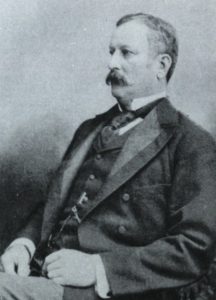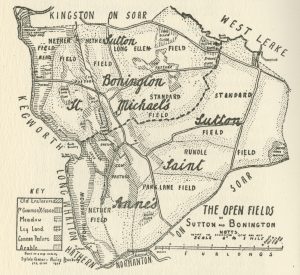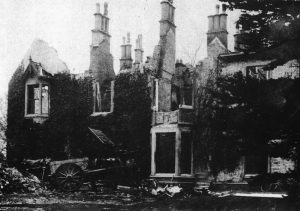March 22, 2021, by Kathryn Steenson
Highlighting the History of Sutton Bonington

Churchwarden & clergy presentment, Sutton Bonington (St Michael), Bingham deanery, 14 May 1632. Ref: AN/PB 315/4/44
Originally, Sutton and Bonington were two settlements, probably originating in Anglo-Saxon times. The two villages gradually grew together and by 1340 had become “Sutton Bonynton”. Today, the villages host to the University of Nottingham’s rural campus.
An insight into 17th century Sutton Bonington is provided by a presentment bill dating from 1632, which forms part of the Archdeaconry of Nottingham Collection. Presentment bills contain reports from parishes and chapelries made by churchwardens and their assistants and give the names
of individuals who were accused of certain offences. These people were liable to be called to answer the charges in person at the meeting of the Correction Court (the Archdeacon’s court was responsible for matters concerning the clergy and for the moral well-being of the parishioners).
The offences listed in this presentment bill are varied. Several parishioners were accused of not attending catechism (religious instruction in the form of questions and answers), and Mr Thoms Savedge, the parson, was accused of “making one side of the churchyard into a garden and a dunghill”. On a more sinister note, Mr Dormor was presented “for breaking Xpofer [Christopher]Melborn’s head in the churchyard”.
Exactly 200 years later, a trade directory from 1832 again provides us with a snapshot of village life. By this time the village had 1136 inhabitants and covered 2000 acres. Trade directories were first published in the late 17th century to promote business but by the 19th century they had expanded to include historical, topographical and biographical information.

History, gazetteer, and directory of Nottinghamshire, and the town and county of the town of Nottingham by William White (1932) Ref: EMSC Not 1.B15.E32
Geographically, Sutton Bonington is a ‘linear’ village – literally a group of buildings formed in a long line. Before Enclosure, it was almost entirely open-field, with existing enclosures being confined to a number of gardens and one or two outlying pieces of land. The Enclosure of 1773 was carried through with little opposition and these two maps show how the land was divided up.
Maps of Sutton Bonington before and after Enclosure from Transactions of the Thoroton Society, volume XXXIV (1930). Ref: EMC Periodicals
Sutton Bonington’s two medieval churches have survived to the present day but sadly some of the older buildings, such as timber-framed cottages, have disappeared. Another casualty was ‘Rependon Grange’, the manor farm belonging to the Prior at Repingdon (Repton) in Derbyshire. This Tudor building was later used as a barn and by the early 1920s had almost completely disappeared, except for a few walls, quantities of stones, and an ivy-clad arch.

Engraving of Rependon Grange, Sutton Bonington from A topographical and historical description of the county of Nottingham by J. Hodgson and F.C. Laird (1813). Ref:
EMSC Not 1.D28 BEA
The Paget family of Loughborough, merchant hosiers and bankers (mentioned in the directory shown above), were the main landowners in Sutton Bonington for much of the 19th century. Sir Ernest Paget was chairman of the Midland Railway Company and together with his wife Sophia played an important part in village life as both employer and benefactor. They lived at Sutton Bonington Hall, which had been purchased by Sir Ernest’s father in the 1820s.

Photograph of Sir Ernest Paget, Bt, 1841-1923, from Remembering Sutton Bonington by Catharine Crawford, 1986
EMC Pamphlet Not 435.D28 CRA
The Paget family also owned St Anne’s Manor and surrounding parkland until it was purchased by Major Charles Richard Tennant, in 1891. Unfortunately, the house caught fire in 1908 and was very badly damaged. Staff at the house together with many of the villagers rescued valuable objects and furniture from the burning building and they were each rewarded with a gold sovereign. Major Tennant rebuilt and enlarged the house, which still stands today.
Photographs of St Anne’s Manor before and after the fire of 1908 from ‘Remembering Sutton Bonington’ by Catharine Crawford, 1986. Ref: EMC Pamphlet Not 435.D28

Newspaper cutting about the fire at St Anne’s Manor from Nottingham Daily Express, 30 December 1908. Ref: Bu C 7/10
In the mid-19th century, the site of the current Sutton Bonington campus was the Midland Dairy Institute, later the Midlands Agricultural and Dairy College. The University and the College had a loose partnership until the two merged when the University of Nottingham was created in 1947. Today the campus is the home of the Schools of Biosciences and Veterinary Medicine, which includes the 1100-acre University Farm and The Centre for Dairy Science Innovation (CDSI), both if which are used for teaching and research. Archives relating to the history of Sutton Bonington, and the University in general, are held at Manuscripts & Special Collections, by appointment only. For more information about the collections, please see the catalogue, and more more information about visiting (including any Covid-19 restrictions) please see our homepage. For more information about our holdings in general, you can also follow us on Twitter and read our magazine, Discover.
No comments yet, fill out a comment to be the first





Leave a Reply